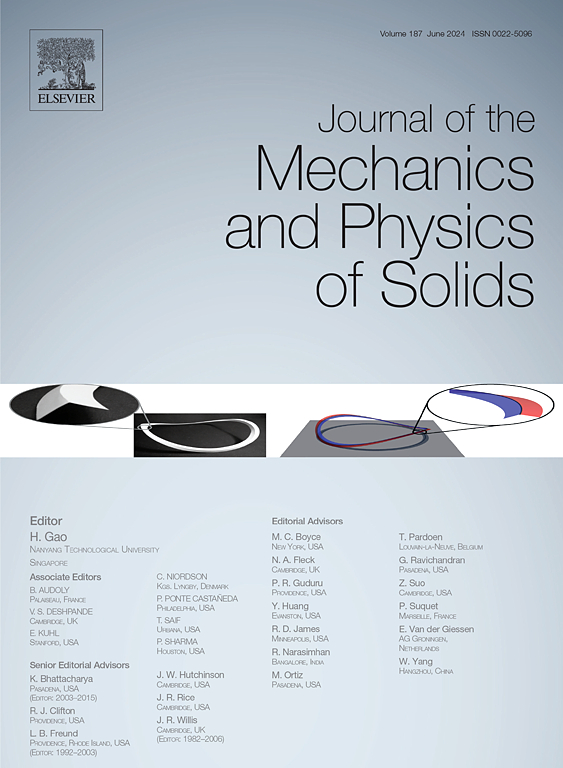逆连续体框架中非线性残余应力场的物理信息恢复
IF 5
2区 工程技术
Q2 MATERIALS SCIENCE, MULTIDISCIPLINARY
引用次数: 0
摘要
残余应力在工业和生物力学应用中都起着重要的机械作用。在生物组织中,残余应力产生于生理或病理条件下的生长和重塑过程,并在非线性弹性的框架内广泛建模。这些建模工作使基于现象学增长规律的残余应力模式的直接计算成为可能。然而,由于测量复杂应力分布的固有挑战,这些模型的实验验证和反馈仍然有限。为了解决这一限制,我们提出并开发了一种利用外部加载配置信息估计非线性残余应力的逆方法。具体而言,该算法采用域位移场和外源载荷作为输入数据,通过双轴测试和数字图像相关(DIC)技术实验获得。这种新颖的公式和数值方案植根于一个物理信息连续体框架,强制执行力学的普遍原则。为了评估该框架,综合生成的地真值解决方案作为参考,允许评估输入数据中不同噪声水平的残余应力场重建的准确性。性能指标表明,当使用多个负载情况和组合数据集时,重建精度有显著提高。该方法为在实验数据基础上制定生长规律和残余模式铺平了道路。本文章由计算机程序翻译,如有差异,请以英文原文为准。
Physics-informed recovery of nonlinear residual stress fields in an inverse continuum framework
Residual stresses play a critical mechanical role in both industrial and biomechanical applications. In biological tissues, residual stresses arise from growth and remodeling processes under physiological or pathological conditions and have been extensively modeled within the framework of nonlinear elasticity. These modeling efforts have enabled direct computation of residual stress patterns based on phenomenological growth laws. However, experimental validation and feedback for these models remain limited due to the inherent challenges in measuring complex stress distributions. To address this limitation, we propose and develop an inverse approach for estimating nonlinear residual stresses using information from an externally loaded configuration. Specifically, the algorithm employs domain displacement fields and externally applied loads as input data, which can be experimentally obtained through biaxial testing and digital image correlation (DIC) techniques. This novel formulation and numerical scheme are rooted in a physics-informed continuum framework that enforces universal principles of mechanics. To evaluate the framework, a synthetically generated ground-truth solution serves as a reference, allowing assessment of the accuracy of residual stress field reconstruction across varying levels of noise in the input data. Performance metrics indicate a significant improvement in reconstruction accuracy when multiple load cases and combined datasets are used. This approach paves the way for the formulation of growth laws and residual patterns based on experimental data.
求助全文
通过发布文献求助,成功后即可免费获取论文全文。
去求助
来源期刊
CiteScore
9.80
自引率
9.40%
发文量
276
审稿时长
52 days
期刊介绍:
The aim of Journal of The Mechanics and Physics of Solids is to publish research of the highest quality and of lasting significance on the mechanics of solids. The scope is broad, from fundamental concepts in mechanics to the analysis of novel phenomena and applications. Solids are interpreted broadly to include both hard and soft materials as well as natural and synthetic structures. The approach can be theoretical, experimental or computational.This research activity sits within engineering science and the allied areas of applied mathematics, materials science, bio-mechanics, applied physics, and geophysics.
The Journal was founded in 1952 by Rodney Hill, who was its Editor-in-Chief until 1968. The topics of interest to the Journal evolve with developments in the subject but its basic ethos remains the same: to publish research of the highest quality relating to the mechanics of solids. Thus, emphasis is placed on the development of fundamental concepts of mechanics and novel applications of these concepts based on theoretical, experimental or computational approaches, drawing upon the various branches of engineering science and the allied areas within applied mathematics, materials science, structural engineering, applied physics, and geophysics.
The main purpose of the Journal is to foster scientific understanding of the processes of deformation and mechanical failure of all solid materials, both technological and natural, and the connections between these processes and their underlying physical mechanisms. In this sense, the content of the Journal should reflect the current state of the discipline in analysis, experimental observation, and numerical simulation. In the interest of achieving this goal, authors are encouraged to consider the significance of their contributions for the field of mechanics and the implications of their results, in addition to describing the details of their work.

 求助内容:
求助内容: 应助结果提醒方式:
应助结果提醒方式:


